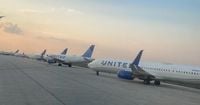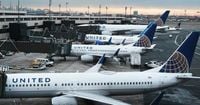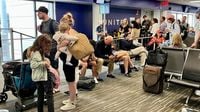United Airlines passengers across the United States and Canada were met with unexpected delays late Tuesday night, September 23, 2025, as the airline briefly suspended all departures due to what it described as a “connectivity issue.” The disruption, which lasted about 30 minutes to an hour depending on the source, marked the second time in less than two months that United had to halt its flights due to a technical glitch—a worrying trend for travelers and industry watchers alike.
According to statements provided to multiple outlets, including CBS News, FOX Business, and Reuters, United Airlines requested the Federal Aviation Administration (FAA) to issue a nationwide ground stop just before midnight Central time. The FAA complied, pausing all United departures at U.S. and Canadian airports. As a spokesperson for the airline told FOX Business, “United experienced a brief connectivity issue just before midnight Central time on Tuesday, but has since resumed normal operations.”
The FAA’s Air Traffic Control System Command Center simply cited the reason for the stop as “COMPANY REQUEST / TECHNOLOGY.” The agency lifted the ground stop at about 1:30 a.m. Eastern time, less than an hour after it was imposed. By Wednesday morning, United’s flights were back up and running, and the airline assured customers that normal service had resumed. The FAA and United have not released further technical details about the nature of the connectivity problem, leaving many to speculate about the vulnerability of airline IT systems.
FlightAware, a flight tracking service, reported 42 delays and four cancellations between midnight and 4 a.m. Eastern time, with Los Angeles International Airport (LAX) being the worst affected. Passengers at LAX and other major hubs found themselves waiting in long lines, dealing with delayed luggage and missed connections. According to NBC News, while the ground stop was relatively brief, its impact rippled across United’s network, demonstrating how even a short technological hiccup can disrupt air travel for thousands.
United’s connectivity issue was not an isolated event. The airline experienced a similar outage in early August 2025. That incident, which United attributed to a “technology issue,” forced a ground stop at major airports including Newark, Denver, Houston, and Chicago. The August disruption lasted several hours, causing widespread delays and cancellations across the network. As United said in a statement at the time, “We expect additional flight delays this evening as we work through this issue. Safety is our top priority, and we’ll work with our customers to get them to their destinations.”
Transportation Secretary Sean Duffy weighed in on both incidents, emphasizing that United’s technical problems were “internal tech outages” and not related to the broader air traffic control system. “United’s issue was internal and not a broader problem with the air traffic control system,” Duffy stated, as reported by several outlets. The FAA supported United through both disruptions, working closely with the airline to restore normal operations as quickly as possible.
For travelers, these back-to-back technology failures have raised concerns about the reliability of airline IT infrastructure, especially as the busy fall and holiday travel seasons approach. As one can imagine, the prospect of being stranded at an airport—whether for 30 minutes or several hours—can be deeply frustrating. The fact that this is the second such incident in two months has not gone unnoticed by passengers, some of whom are growing uneasy about United’s ability to keep its systems running smoothly.
The financial markets also took notice. According to FOX Business, United Airlines Holdings Inc. (UAL) saw its stock price drop by 2.63% following the latest incident, reflecting investor unease about the airline’s technical resilience and the potential for further disruptions.
United is not alone in grappling with IT challenges. Alaska Airlines, for instance, faced similar issues in July 2025 and April 2024, grounding all flights for several hours due to IT outages. These events highlight a broader vulnerability within the aviation industry, where complex, interconnected systems mean that a single glitch can have outsized effects on operations.
Ground stops are a standard tool in the FAA’s arsenal for managing air traffic disruptions. According to the FAA’s own guidance, ground stops require “aircraft that meet a specific criteria to remain on the ground.” They can be airport, airspace, or equipment-specific, and are often implemented with little to no warning. In United’s case, both the August and September ground stops were requested by the airline itself, underscoring the seriousness of the technical issues at hand.
While United has not provided detailed explanations for the connectivity issues, the airline has consistently emphasized its commitment to safety and customer service. After both incidents, United issued statements apologizing for the inconvenience and assuring customers that it was working to resolve the problems as quickly as possible. Yet, for many passengers, the lack of transparency about the root causes of these outages remains a point of frustration.
Industry analysts note that as airlines rely more heavily on digital systems for everything from flight operations to customer service, the risk of IT failures increases. The aviation sector faces the dual challenge of maintaining legacy systems while integrating new technologies—a balancing act that can sometimes result in unexpected outages. As the holiday season looms and travel demand surges, airlines will be under pressure to shore up their IT defenses and reassure travelers that such disruptions will not become the norm.
During the most recent ground stop, the impact was felt most acutely at major hubs like LAX, Newark, Houston, Denver, and Chicago. Passengers reported confusion and anxiety as flight information boards lit up with delays and cancellations. Some found themselves stranded overnight, while others scrambled to rebook connections or retrieve delayed luggage. The airline’s customer service teams worked overtime to manage the fallout, but the episode was a stark reminder of the fragility of modern air travel when technology falters.
Despite the challenges, United’s quick response and the relatively short duration of the ground stop helped to limit the disruption. By early Wednesday morning, flights had resumed, and the airline was working to clear the backlog. Still, with two major IT-related ground stops in as many months, United faces mounting pressure to address the underlying issues and restore confidence among its customers and investors.
As the aviation industry continues to modernize, the United Airlines incidents serve as a cautionary tale. Reliable technology is no longer a luxury—it’s a necessity for keeping passengers moving and businesses thriving. For now, travelers can only hope that airlines are learning from these experiences and taking steps to prevent future disruptions.



